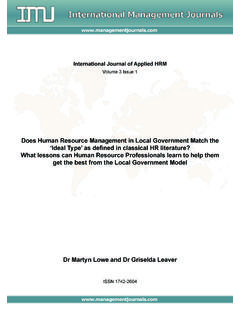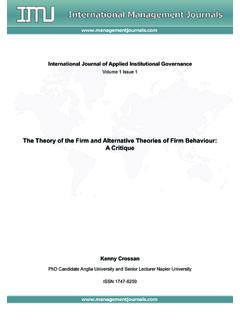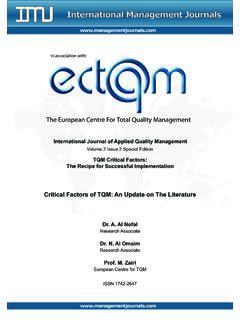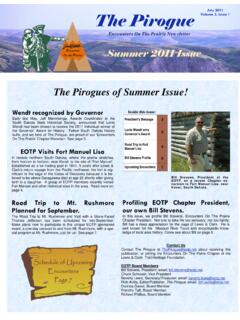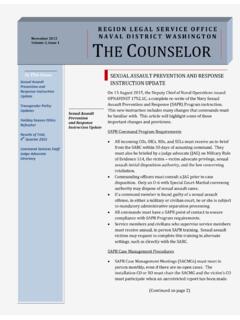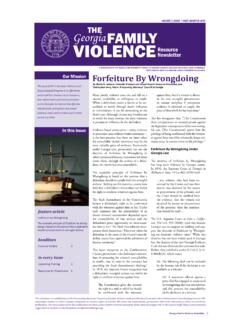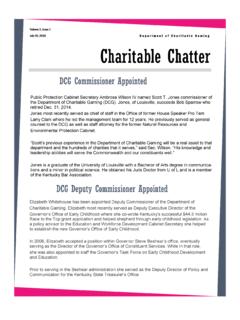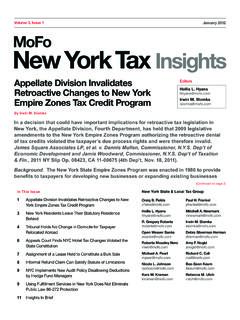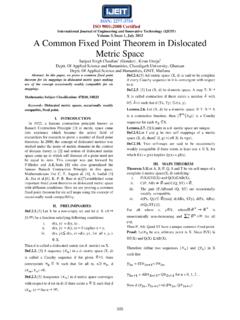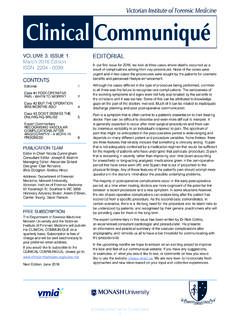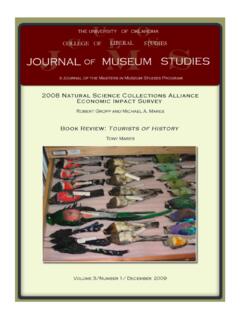Transcription of Volume 3 Issue 1 - Management Journals
1 International Management Journal of Applied HRMV olume 3 Issue 1 Employee Loyalty at the Workplace: The Impact of Japanese Style of Human Resource ManagementHooi Lai WanISSN 1742-2604 International Journal of Applied HRM: Volume 3 Issue 1 Introduction In this era of globalization and liberalization, employees are becoming the competitive advantage for business. A business may manage with mediocre employees but competent employees can propel an average business to greater heights. Likewise, bad employees can cause flourishing business empires to collapse. In a tight labor market, keeping good employees and developing employee loyalty becomes increasingly important and a continuing challenge. With the tight labor market, employers therefore need a strategy to retain their key experts and crucial skilled workers. As prospective employers continuously bid for top performers, Management strategies must therefore give due consideration and sufficient resource allocation to keep employees motivated and satisfied.
2 The idea is that the satisfied employee is less likely to pursue greener pastures. Thus, implementing desirable human resource Management policies will have a positive effect on employee loyalty. Japan obviously relies extensively on its human capital to fulfill its national economic objectives. The "Look East Policy" was developed to emulate Japanese style of Management , especially human resource Management . Japanese human resource Management places great emphasis on the internal labor market to fill promotion opportunities, long-term development programs and job security, among others. All these are contributory factors for employee loyalty. For Malaysia to sustain economic growth, appropriate human resource Management policies that promote employee loyalty are essential. Continuous and systematic approach to training and development, recruitment policies that reduce job-hopping and ensure long-term employment, internal promotion practices with a little recognition given to seniority and the implementation of the productivity-linked wage system would create a more committed employee towards the company.
3 As most of these elements are representative of Japanese style of human resource Management which enhance employee loyalty and encourages long-term employment, the hypothesis for this study is employee loyalty would be higher in companies where elements of Japanese style of human resource Management are present. The main purpose of this study is to define and model the approach of developing employee loyalty through human resource Management policies by identifying human resource Management policies that augments employee loyalty and analyzing if Japanese style of human resource Management does have a role in enhancing employee loyalty. For this research, the extent of Japanese style of human resource Management introduced and adopted by the small and medium size manufacturing companies in Malaysia is first analyzed so as to segment the participating companies into three groups, depending on the extent of Japanese style of human resource Management introduced in their Management practices.
4 Page 1 International Journal of Applied HRM: Volume 3 Issue 1 Rationale and Theoretical Framework For the purpose of this study, the research background and the statement of hypothesis for this paper will first be outlined. Then, a review of related literature on this topic will be detailed with reference to books, academic papers, Journals and the Internet. Three areas will be discussed: the definition of employee loyalty, employee loyalty at the workplace and the correlation between human resource Management policies and employee loyalty. Next, the research methodology for this research will outline the sample for the survey and the method used in the collection of data. The collected data will then be analyzed to prove the validity of the hypothesis. Lastly, conclusions for the entire research project will be discussed.
5 Literature Review (a) Defining Employee Loyalty In general, employee loyalty can be defined as a psychological attachment or commitment to the organization and develops as a result of increase satisfaction. Satisfaction results from a process of internal evaluation, and if an employee s expectation level is met or exceeded, then satisfaction grows. Employee loyalty then develops into a generalized emotional attitude towards the organization. In other words, the more satisfied an employee is regarding his or her working environment, the more likely that he or she will develop a sense of commitment towards the organization in general. Employee attitudes towards the organization then give rise to the behavioral component of loyalty. An employee who has developed an affection to the organization is more likely to demonstrate loyal behaviors and work towards the overall goals of the organization, such as improved productivity, greater efficiency, and a high-quality service orientation to customers.
6 Both the attitudinal and behavioral components of employee loyalty can be measured by aggregating four indicators into a single metric that can be monitored over time using the Satmetrix Systems Employee Loyalty Index. These indicators include overall satisfaction with manager, deserves my loyalty, likelihood to continue working at organization and likelihood to provide referrals for organization. The first two indicators measure the attitudinal component of employee loyalty and others measure the behavioral component of employee loyalty Using the ELI, not only can levels of overall employee loyalty be measured and tracked over time as leading performance indicators, driver analyses can also be conducted to determine which specific attributes of the working environment most impact employee loyalty. Indeed, empirical evidence has shown that companies who maintain high employee loyalty scores also enjoy high levels of customer loyalty and corporate profitability (Reichheld, 1996).
7 For example, in a landmark study conducted by the retail giant Sears, Roebuck & Co., researchers showed that a 5 point improvement in employee loyalty can drive a point improvement in customer loyalty, which in turn drives a improvement in revenue growth (Rucci, Kirn and Quinn, 1998). However, organizations are often confronted with the fact that today s definition of employee loyalty is inherently complex. No longer is the traditional notion of Page 2 International Journal of Applied HRM: Volume 3 Issue 1 employee loyalty once defined as a lifetime relationship with a particular employer appropriate in the current marketplace of layoffs, mergers and talent wars. In other words, a longer tenured employee does not necessarily and sufficiently indicates high loyalty towards an The following section will analyze employee loyalty at the work place.
8 (b) Employee Loyalty At The Workplace Recent data collected by The Empower Group for The Manpower International Employee Loyalty Survey, 2002, suggests that employee loyalty continues to rise around the world. Human resource managers in eight countries (United States, France, Germany, Italy, Japan, Mexico, the Netherlands, and the United Kingdom) not only say that employee loyalty has increased in the past three years but also are optimistic about employee loyalty over the next three years as well. 42% expect their employees loyalty to grow over the next three years while only 10% feel it will be on the decline. Close to three quarters of employees (72%) interviewed in the UK and US state that they currently feel loyal towards their companies. Loyalty may not be as strong as it used to be in the post-war job for life era, but it is still strong. The survey findings reveal that, amongst UK/US employees over twice as many individuals (25%) expect their loyalty towards their companies to grow over the next three years as compared with those who expect it to decrease (only 11%).
9 Over half (57%) expect their loyalty levels to remain at their current level. The study found that loyalty, as measured by retention rates, were the highest in Mexico, the Netherlands and the United States. The lowest levels were recorded in Japan and Italy. Employees with three- to five-years tenure with employers were the most susceptible to turnover. Loyalty levels among women were 76 percent, compared with 68 percent for On the contrary, research by Next Generation Consulting shows that today s young talent rotates jobs every 18-36 months. As both college degrees and employers don t guarantee job anymore, job changes in a career is becoming the norm. There are fewer promotional opportunities and by the time they re 32, today s young talent have had an average of nine jobs and have thought about or gone back to school or started their own A recent survey by the Gallup Organization and International Survey Research (ISR) found only four percent of workers in Singapore to be "engaged", defined as loyal and Most were described as "productive but not committed to the organization, and would leave" if an opportunity came.
10 The ISR survey also showed that poor corporate leadership was a prime factor in workers' lack of commitment. One insight from Gallup's findings was that the percentage of this group had grown from last year's study, and that this has corresponded with a period of deepening employment uncertainty. The ISR survey from 1999 to last year, covering 60,000 employees in 60 companies, saw widespread retrenchment and "multitasking" getting more pronounced for those who kept their jobs. According to 2001 National Employee Benchmark Study on the United States, the incidence of True Loyalty (employees committed to the organization and planning to stay for at least two years) remains at just 24% nationally, the same as in 1999. 34% of the employees are AT Risk (employees neither committed nor planning to stay) compared to 33% in 1999. Fewer employees in 2001 are considered Trapped Page 3 International Journal of Applied HRM: Volume 3 Issue 1 (not committed to employer but still plan to stay for at least two years) than in 1999 (37% Trapped in 2001 compared to 39% in 1999).

